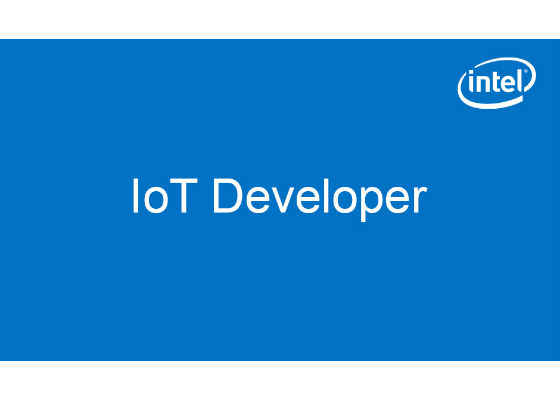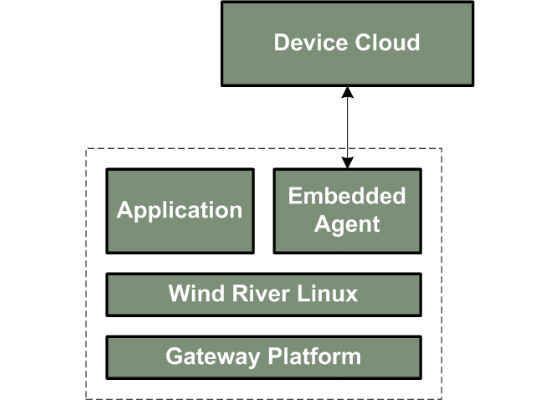IoT Gateways and the Wind River Helix Cloud

Wind River* Helix* Cloud is an interconnected set of cloud-enabled services that work seamlessly together. Internet of Things (IoT) gateways use these capabilities for development, testing, and deployment. This article explores these IoT gateways and shows how they benefit from Helix Cloud. An IoT gateway is a common device in IoT infrastructures, and includes a variety of interfaces for connectivity to low-level devices and Internet-based protocols for communication with the cloud.
Developing, testing, and deploying in the cloud
Helix Cloud is a cloud-based platform that supports the firmware development life cycle (see Figure 1). It supports firmware development with Wind River* Helix* App Cloud, using a web-based integrated development environment (IDE), debugging and testing with Wind River* Helix*Lab Cloud (from a web console), and deployment with Wind River* Helix* Device Cloud (through a single web console or from your own enterprise IT environment through Representational State Transfer [REST]-full application programming interfaces).
Figure 1. Connectivity between services in Wind River* Helix* Cloud
These cloud-based services cover a variety of processor architectures, from various flavors of Intel® x86 processors to PowerPC and ARM*. This broad range of processor architectures supports the development of simple and complex edge devices as well as IoT gateways.
Another useful aspect of Helix Cloud is the connectivity between services. From App Cloud, you can develop firmware and select a session on which to execute your code (from Lab Cloud). You can access Lab Cloud directly to create and connect to virtual devices (called sessions) for firmware debugging and testing. From an integration standpoint, from Lab Cloud you can select a virtual session, and then bring up App Cloud on that session to execute firmware.
Engineering a change in the IoT
Helix Cloud represents a significant change in the development of IoT products. Rather than focus on one aspect of the production of IoT devices, Helix Cloud covers the entire life cycle of product development, from building firmware to validating devices to deploying and managing devices in the field.
Wind River also provides components that you can use for integration into the overall Helix Cloud. One example is the embedded software agent that’s deployed within IoT gateways. This agent implements standard protocols for monitoring and management of the IoT gateway in the field in a secure and standards-based fashion.
Increasing speed, lowering cost, and reducing risk
Helix Cloud provides many benefits for the development of IoT components such as edge devices and gateways. You can access App Cloud, as a web-based IDE, from any modern web browser, which means that you can develop anywhere you have an Internet connection.
Because the IDE is stateful, when you exit the browser from work, and then bring it back up when you arrive at home, the IDE is just where you left it.
When using Lab Cloud for testing, it’s easy to create a virtual device, and then debug your embedded application. Another benefit of Lab Cloud is its ability to take snapshots of running sessions. The snapshot is the state of the session at a given time. From a test point of view, snapshots make it easy to zero in on a bug. Then, by sharing the snapshot, you can watch the issue in action, more quickly identify the root cause, and resolve it, reducing cost and increasing time to market.
For a gateway application, you can easily take your portable source and compile and test on a variety of gateway devices and configurations within Lab Cloud. This parallelized testing makes it faster to find issues and pinpoint them on specific hardware or device configurations. When your testing is complete, you can integrate the image that App Cloud creates into your physical gateway.
Device Cloud simplifies your ability to scale your gateway application with Wind River’s cloud-based infrastructure. When using Wind River’s embedded agent, your IoT gateway includes everything it needs for secure data transfer and manageability, such as data capture, configuration, and rules-based data analysis (Figure 2). Device Cloud allows you to focus on your IoT application, leaving standard capabilities like firmware update and IoT communication protocols that integrate cleanly into Device Cloud.
Figure 2. The Wind River* Helix* Device Cloud agent
IoT and the gateway
As the name implies, the IoT gateway is a conduit within an IoT ecosystem for data collection and transmission as well as manageability.
As a standard device in an IoT environment, many off-the-shelf parts and components are available for use to simplify your development.
The physical hardware for an IoT gateway is a specialized set of processor cores and interfaces that provide access to sensors and actuators. Intel provides off-the-shelf hardware that satisfies these needs across target IoT markets, including single- and multicore processors, to meet your specific gateway application requirements. These devices also include several communications and connectivity options, such as Wi-Fi*, Bluetooth*, cellular interfaces, serial ports, and USB. These options provide everything you need to access sensors and communicate your collected data beyond the gateway and into the cloud.
The gateway and the cloud
An IoT gateway is a bridge that accesses a variety of buses and interfaces to the edge devices that lie beyond, for the purposes of data collection and manipulation (if actuators are present). Data communication and controls are exposed to the cloud through higher-bandwidth interfaces such as Ethernet or Wi-Fi. The gateway is an integral part of any IoT ecosystem, forming a hierarchy. Rather than the cloud knowing about every low-level device that exists, the gateway mediates between the cloud and edge devices. In addition to sensor and actuator access, the IoT gateway includes functions necessary for management and security.
As the world becomes more connected through the IoT, the need to protect these devices against unauthorized access and secure their data increases. The gateway is an ideal place for this security because edge devices tend to be less powerful, and in many cases lack the ability to connect directly to the cloud. The gateway fills this niche, exposing the heavier-weight protocols such as Message Queuing Telemetry Transport (MQTT) to the cloud with enough processing capability to gather and process sensor data and control devices that can be manipulated.
For more such intel IoT resources and tools from Intel, please visit the Intel® Developer Zone
Source:https://software.intel.com/en-us/articles/iot-gateways-and-the-wind-river-helix-cloud






